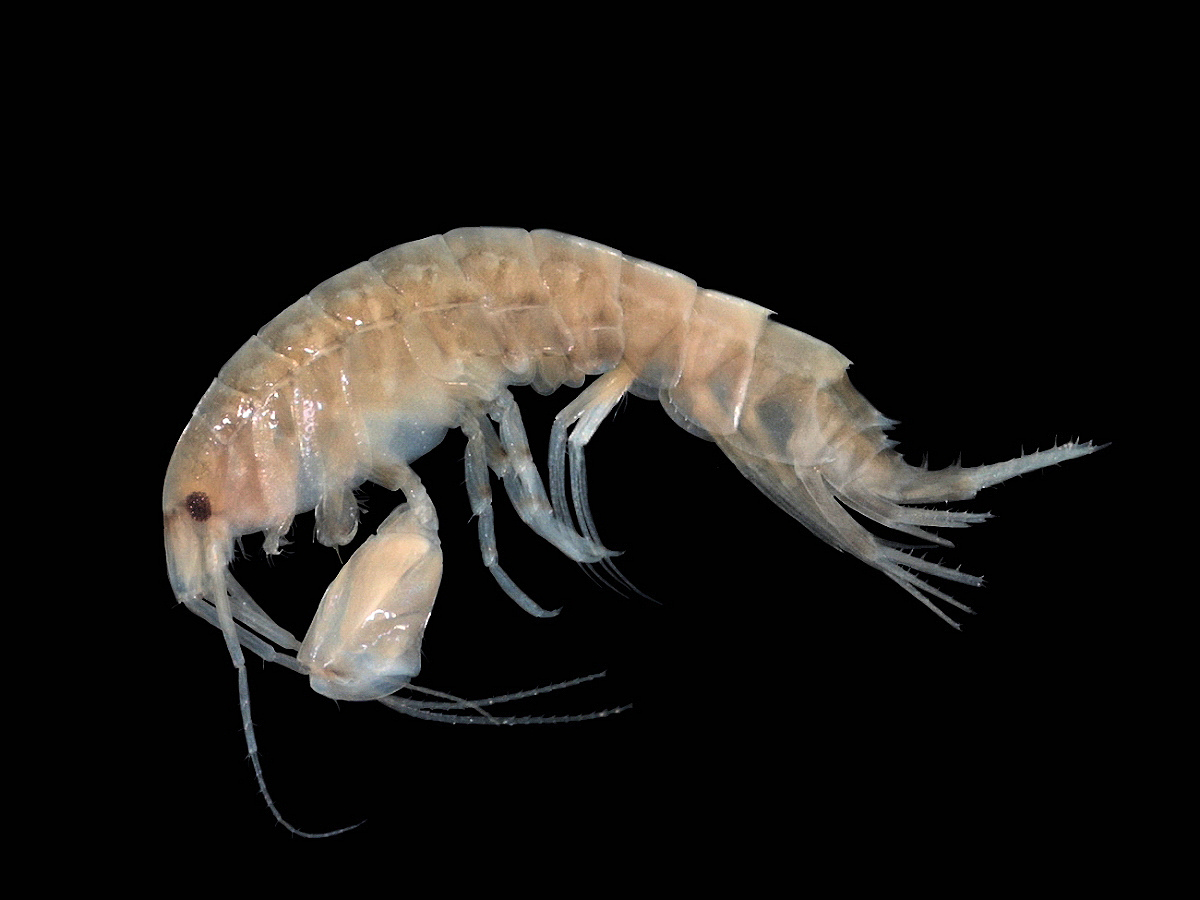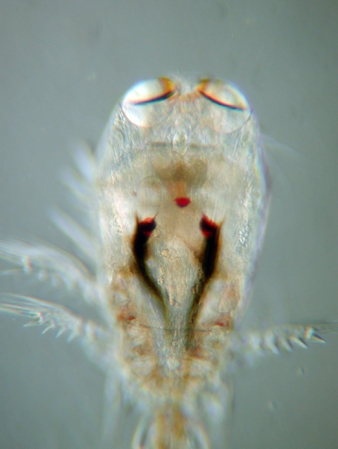|
Calanoides Acutus
''Calanoides acutus'' is a copepod Copepods (; meaning "oar-feet") are a group of small crustaceans found in nearly every freshwater and saltwater habitat (ecology), habitat. Some species are planktonic (inhabiting sea waters), some are benthos, benthic (living on the ocean floor) ... found in Antarctica and the surrounding waters. Description The female ranges from about , and the male has an average length of about . Distribution ''C. acutus'' is found in Antarctic and sub-Antarctic waters, from sea level to in depth. Ecology Life history and reproduction While ''C. acutus'' is only confirmed to breed from November to March, it likely starts breeding in early October, as a study observed females without eggs and late-stage nauplii presumably belonging to this copepod in mid-November. Stage I through III copepodites are generally found from sea level to of depth. Older stages, on the other hand, are found in the top during the summer, except during December, when they ar ... [...More Info...] [...Related Items...] OR: [Wikipedia] [Google] [Baidu] |
Animal
Animals are multicellular, eukaryotic organisms in the Kingdom (biology), biological kingdom Animalia. With few exceptions, animals Heterotroph, consume organic material, Cellular respiration#Aerobic respiration, breathe oxygen, are Motility, able to move, can Sexual reproduction, reproduce sexually, and go through an ontogenetic stage in which their body consists of a hollow sphere of Cell (biology), cells, the blastula, during Embryogenesis, embryonic development. Over 1.5 million Extant taxon, living animal species have been Species description, described—of which around 1 million are Insecta, insects—but it has been estimated there are over 7 million animal species in total. Animals range in length from to . They have Ecology, complex interactions with each other and their environments, forming intricate food webs. The scientific study of animals is known as zoology. Most living animal species are in Bilateria, a clade whose members have a Symmetry in biology#Bilate ... [...More Info...] [...Related Items...] OR: [Wikipedia] [Google] [Baidu] |
Arthropod
Arthropods (, (gen. ποδός)) are invertebrate animals with an exoskeleton, a Segmentation (biology), segmented body, and paired jointed appendages. Arthropods form the phylum Arthropoda. They are distinguished by their jointed limbs and Arthropod cuticle, cuticle made of chitin, often Mineralization (biology), mineralised with calcium carbonate. The arthropod body plan consists of segments, each with a pair of appendages. Arthropods are bilaterally symmetrical and their body possesses an exoskeleton, external skeleton. In order to keep growing, they must go through stages of moulting, a process by which they shed their exoskeleton to reveal a new one. Some species have wings. They are an extremely diverse group, with up to 10 million species. The haemocoel, an arthropod's internal cavity, through which its haemolymph – analogue of blood – circulates, accommodates its interior Organ (anatomy), organs; it has an open circulatory system. Like their exteriors, the internal or ... [...More Info...] [...Related Items...] OR: [Wikipedia] [Google] [Baidu] |
Crustacean
Crustaceans (Crustacea, ) form a large, diverse arthropod taxon which includes such animals as decapods, seed shrimp, branchiopods, fish lice, krill, remipedes, isopods, barnacles, copepods, amphipods and mantis shrimp. The crustacean group can be treated as a subphylum under the clade Mandibulata. It is now well accepted that the hexapods emerged deep in the Crustacean group, with the completed group referred to as Pancrustacea. Some crustaceans ( Remipedia, Cephalocarida, Branchiopoda) are more closely related to insects and the other hexapods than they are to certain other crustaceans. The 67,000 described species range in size from '' Stygotantulus stocki'' at , to the Japanese spider crab with a leg span of up to and a mass of . Like other arthropods, crustaceans have an exoskeleton, which they moult to grow. They are distinguished from other groups of arthropods, such as insects, myriapods and chelicerates, by the possession of biramous (two-parted) l ... [...More Info...] [...Related Items...] OR: [Wikipedia] [Google] [Baidu] |
Maxillopoda
Crustaceans (Crustacea, ) form a large, diverse arthropod taxon which includes such animals as decapods, seed shrimp, branchiopods, fish lice, krill, remipedes, isopods, barnacles, copepods, amphipods and mantis shrimp. The crustacean group can be treated as a subphylum under the clade Mandibulata. It is now well accepted that the hexapods emerged deep in the Crustacean group, with the completed group referred to as Pancrustacea. Some crustaceans (Remipedia, Cephalocarida, Branchiopoda) are more closely related to insects and the other hexapods than they are to certain other crustaceans. The 67,000 described species range in size from '' Stygotantulus stocki'' at , to the Japanese spider crab with a leg span of up to and a mass of . Like other arthropods, crustaceans have an exoskeleton, which they moult to grow. They are distinguished from other groups of arthropods, such as insects, myriapods and chelicerates, by the possession of biramous (two-parted) limbs, and by their ... [...More Info...] [...Related Items...] OR: [Wikipedia] [Google] [Baidu] |
Copepod
Copepods (; meaning "oar-feet") are a group of small crustaceans found in nearly every freshwater and saltwater habitat. Some species are planktonic (inhabiting sea waters), some are benthic (living on the ocean floor), a number of species have parasitic phases, and some continental species may live in limnoterrestrial habitats and other wet terrestrial places, such as swamps, under leaf fall in wet forests, bogs, springs, ephemeral ponds, and puddles, damp moss, or water-filled recesses (phytotelmata) of plants such as bromeliads and pitcher plants. Many live underground in marine and freshwater caves, sinkholes, or stream beds. Copepods are sometimes used as biodiversity indicators. As with other crustaceans, copepods have a larval form. For copepods, the egg hatches into a nauplius form, with a head and a tail but no true thorax or abdomen. The larva molts several times until it resembles the adult and then, after more molts, achieves adult development. The nauplius form is so ... [...More Info...] [...Related Items...] OR: [Wikipedia] [Google] [Baidu] |
Calanoida
Calanoida is an order of copepods, a group of arthropods commonly found as zooplankton. The order includes around 46 families with about 1800 species of both marine and freshwater copepods between them. Description Calanoids can be distinguished from other planktonic copepods by having first antennae at least half the length of the body and biramous second antennae. However, their most distinctive anatomical trait is the presence of a joint between the fifth and sixth body segments. The largest specimens reach long, but most do not exceed long. Classification Calanoida contains the following families, as well as the genus '' Microdisseta'' (which is currently ''incertae sedis''); * Acartiidae * Aetideidae * Arctokonstantinidae * Arietellidae * Augaptilidae * Bathypontiidae * Calanidae * Calocalanidae * Candaciidae * Centropagidae * Clausocalanidae * Diaixidae * Diaptomidae * Discoidae * Epacteriscidae * Eucalanidae * Euchaetidae * Fosshageniidae * Heterorha ... [...More Info...] [...Related Items...] OR: [Wikipedia] [Google] [Baidu] |
Calanidae
Calanidae is the largest taxonomic family of calanoid copepods. It includes the genus '' Calanus'', which may be the most abundant metazoan genus on Earth. Copepods of the genera '' Calanus'' and ''Neocalanus'' are ecologically important in the Arctic and subarctic regions of the world's oceans. Genera The family contains the following genera: *'' Calanoides'' *'' Calanus'' *'' Canthocalanus'' *'' Cosmocalanus'' *'' Mesocalanus'' *'' Metranura'' *'' Nannocalanus'' *''Neocalanus ''Neocalanus'' is a genus of marine copepods. They are a dominant component of the open water ecosystems of the northern Pacific Ocean. ''Neocalanus'' are large copepods, reaching body lengths (i.e., prosome length) of more than in ''Neocalanus ...'' *'' Undinula'' References External links * Guide to the marine zooplankton of south eastern Australia Calanoida Taxa named by James Dwight Dana Crustacean families {{Calanoida-stub ... [...More Info...] [...Related Items...] OR: [Wikipedia] [Google] [Baidu] |
Wilhelm Giesbrecht
Wilhelm Giesbrecht (1854–1913) was a Prussian zoologist, specialising in copepods, during the "golden age of copepodology". Giesbrecht was born in Gdańsk in 1854, and was educated in Kiel, where in 1881 he earned a Ph.D. in Baltic copepods under Professor Karl Möbius. He then moved to Naples to work at the zoological station there, staying there for the remainder of his life. His most famous work is the 1892 monograph Systematik und Faunistik der pelagischen Copepoden des Golfes von Neapel und der angrenzenden Meeres-Abschnitte' ("Systematics and faunistics of the pelagic copepods of the Gulf of Naples and neighbouring seas"). In 1904, at the request of Anton Dohrn, Giesbrecht was made an honorary professor. He is commemorated in a number of species names: *''Prostheceraeus giesbrechtii'' Lang, 1884 *'' Buntonia giesbrechti'' (G. W. Müller, 1894) *'' Onchocorycaeus giesbrechti'' (F. Dahl, 1894) *''Stenhelia giesbrechti'' T. & A. Scott, 1896 *'' Pseudocyclopia giesbrechti'' ... [...More Info...] [...Related Items...] OR: [Wikipedia] [Google] [Baidu] |
Copepod
Copepods (; meaning "oar-feet") are a group of small crustaceans found in nearly every freshwater and saltwater habitat. Some species are planktonic (inhabiting sea waters), some are benthic (living on the ocean floor), a number of species have parasitic phases, and some continental species may live in limnoterrestrial habitats and other wet terrestrial places, such as swamps, under leaf fall in wet forests, bogs, springs, ephemeral ponds, and puddles, damp moss, or water-filled recesses (phytotelmata) of plants such as bromeliads and pitcher plants. Many live underground in marine and freshwater caves, sinkholes, or stream beds. Copepods are sometimes used as biodiversity indicators. As with other crustaceans, copepods have a larval form. For copepods, the egg hatches into a nauplius form, with a head and a tail but no true thorax or abdomen. The larva molts several times until it resembles the adult and then, after more molts, achieves adult development. The nauplius form is so ... [...More Info...] [...Related Items...] OR: [Wikipedia] [Google] [Baidu] |
Drake Passage
The Drake Passage (referred to as Mar de Hoces Hoces Sea"in Spanish-speaking countries) is the body of water between South America's Cape Horn, Chile and the South Shetland Islands of Antarctica. It connects the southwestern part of the Atlantic Ocean ( Scotia Sea) with the southeastern part of the Pacific Ocean and extends into the Southern Ocean. The Drake Passage is considered one of the most treacherous voyages for ships to make. Currents at its latitude meet no resistance from any landmass, and waves top , hence its reputation as "the most powerful convergence of seas". As the Drake Passage is the narrowest passage around Antarctica, its existence and shape strongly influence the circulation of water around Antarctica and the global oceanic circulation, as well as the global climate. The bathymetry of the Drake Passage plays an important role in the global mixing of oceanic water. It is one of the most treacherous bodies of water on earth. History Sailing south from th ... [...More Info...] [...Related Items...] OR: [Wikipedia] [Google] [Baidu] |
Fauna Of The Southern Ocean
The Southern Ocean, also known as the Antarctic Ocean, comprises the southernmost waters of the World Ocean, generally taken to be south of 60° S latitude and encircling Antarctica. With a size of , it is regarded as the second-smallest of the five principal oceanic divisions: smaller than the Pacific, Atlantic, and Indian oceans but larger than the Arctic Ocean. Over the past 30 years, the Southern Ocean has been subject to rapid climate change, which has led to changes in the marine ecosystem. By way of his voyages in the 1770s, James Cook proved that waters encompassed the southern latitudes of the globe. Since then, geographers have disagreed on the Southern Ocean's northern boundary or even existence, considering the waters as various parts of the Pacific, Atlantic, and Indian oceans, instead. However, according to Commodore John Leech of the International Hydrographic Organization (IHO), recent oceanographic research has discovered the importance of Southern C ... [...More Info...] [...Related Items...] OR: [Wikipedia] [Google] [Baidu] |






